Where is this useful?
The Least Common Ancestor (LCA) data structure is useful wherever you have a directed graph where every vertex has out-degree \(\leq 1\). In more common terms, each vertex has a unique determined ‘parent’, or it is a root node, with no parent. The most common (and almost always only) example being a rooted tree.
On these particular graphs, the LCA gives us a fast way to move ‘up’ the graph (Towards your parents). In particular, we can use this to find the least common ancestor in \(\log (N)\) time, where the data structure gets its name from.
Reusing the analogy of parenting vertices, a vertex \(u\) is an ancestor of \(v\) if \(u\) is \(v\)’s parent, or \(v\)’s parent’s parent, and so on. As long as there is a line of ‘parentage’ connecting \(v\) to \(u\), \(u\) is an ancestor of \(v\). We consider \(v\) to also be it’s own ancestor.
The least common ancestor problem then requires, given two vertices \(x\) and \(y\), to find a vertex \(z\) in the graph such that \(z\) is an ancestor of both \(x\) and \(y\), but there is no vertex \(z’ \neq z\) such that \(z\) is an ancestor of \(z’\) and \(z’\) is an ancestor of \(x\) and \(y\) (In the tree example, we just want to find the lowest depth vertex whose subtree contains boths \(x\) and \(y\)).
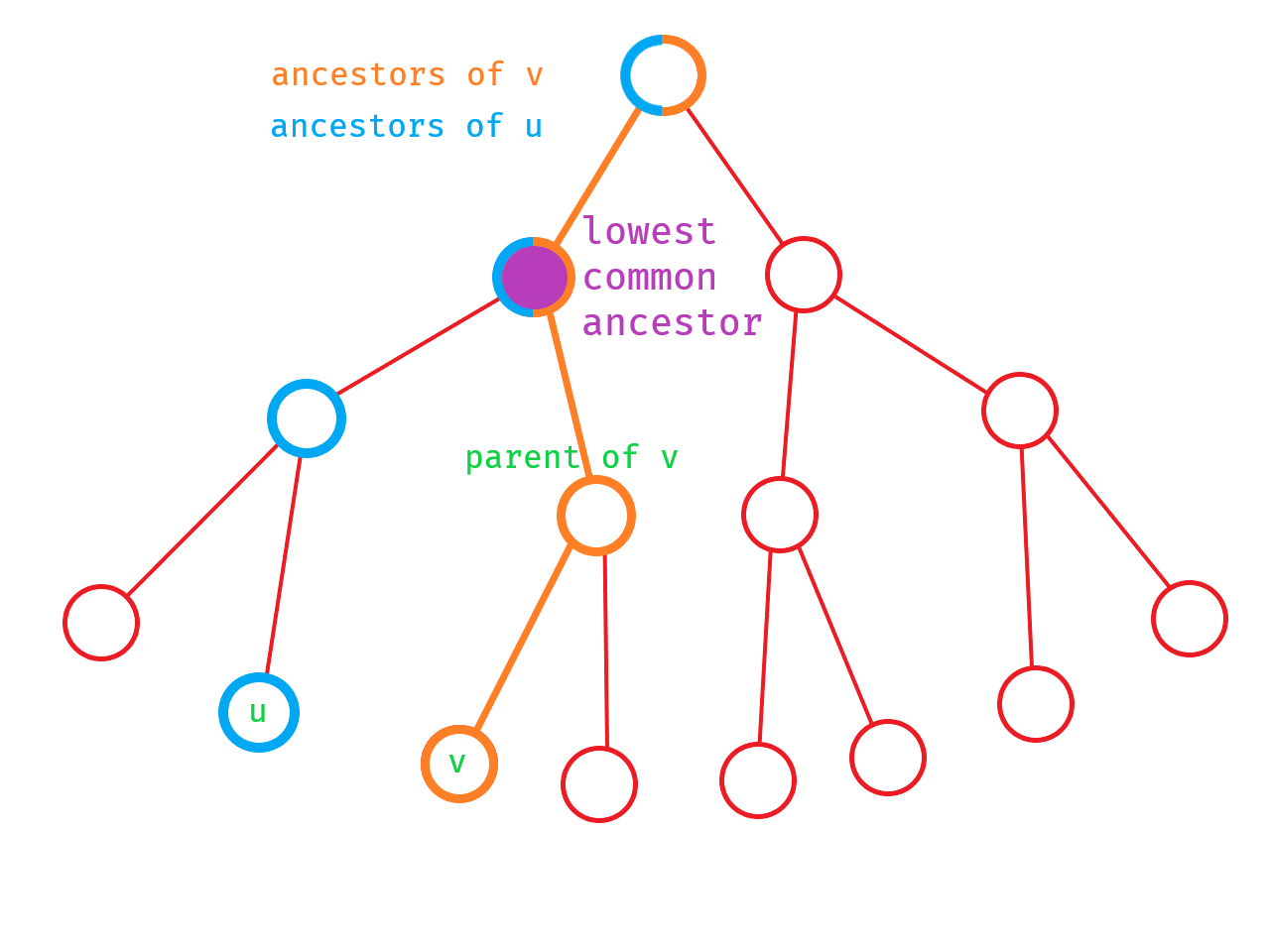
Note that the least common ancestor can be \(x\) or \(y\), if \(x\) is an ancestor of \(y\) or vice-versa.
Implementing the Data Structure
Interface
Let’s start by defining an interface for this data structure, and then slowly implement our methods.
1
2
3
4
5
6
7
8
9
10
11
12
13
14
15
16
17
18
19
20
21
22
23
24
25
class LCA:
"""
vertices are represented as numbers 0->n-1.
"""
def __init__(self, n_vertices):
self.n = n_vertices
self.adjacent = [[] for _ in range(self.n)]
def add_edge(self, u, v, weight=1):
self.adjacent[u].append((v, weight))
self.adjacent[v].append((u, weight))
def build(self, root):
# Once edges are added, build the tree/data structure.
pass # TODO
def query(self, u, v, root=None):
# What is the lowest common ancestor of u, v?
# Extension: Make this query from any root vertex you want.
pass # TODO
def dist(self, u, v):
# Find the distance between two vertices - very simple if we have LCA.
pass # TODO
1
2
3
4
5
6
7
8
9
10
11
12
13
14
15
16
17
18
19
20
21
22
23
24
25
26
27
template<typename T = int> struct LCA {
// vertices are represented as numbers 0->n-1.
int n; vector<vector<pair<int, T> > > adjacent;
LCA(int n_vertices) : n(n_vertices), adjacent(n) { }
void add_edge(int u, int v, T weight=1) {
adjacent[u].emplace_back(v, weight);
adjacent[v].emplace_back(u, weight);
}
void build(int root=0) {
// Once edges are added, build the tree/data structure.
// TODO
}
int query(int u, int v, int root=-1) {
// What is the lowest common ancestor of u, v?
// Extension: Make this query from any root vertex you want.
// TODO
}
T dist(int u, int v) {
// Find the distance between two vertices - very simple if we have LCA.
// TODO
}
}
Useful data
First off, let’s save some intermediary data that will make our life a lot easier, and strictly define the tree structure. We’ll introduce three arrays: parent, level and length.
parentstores the direct parent of any vertex in the rooted tree.levelstores the level of the tree the vertex is at (Number of edges from it to the root)lengthstores the length of the vertex to the root (Using edge weights).
We’ll populate these fields in the build method, since all edges should be added by then.
1
2
3
4
5
6
7
8
9
10
11
12
13
14
15
16
17
18
19
20
21
22
23
24
25
26
27
28
29
30
31
32
33
34
35
36
37
class LCA:
"""
vertices are represented as numbers 0->n-1.
"""
def __init__(self, n_vertices):
self.n = n_vertices
self.adjacent = [[] for _ in range(self.n)]
def add_edge(self, u, v, weight=1):
self.adjacent[u].append((v, weight))
self.adjacent[v].append((u, weight))
def dfs(self, source, c_parent, c_level, c_length):n
# Search from the source down the tree and set parent, level, length accordingly.n
self.parent[source] = c_parentn
self.level[source] = c_leveln
self.length[source] = c_lengthn
for child, weight in self.adjacent[source]:n
if child != c_parent:n
self.dfs(child, source, c_level + 1, c_length + weight)n
def build(self, root):
# Once edges are added, build the tree/data structure.
self.parent = [None]*self.nn
self.level = [None]*self.nn
self.length = [None]*self.nn
self.dfs(root, -1, 0, 0)n
def query(self, u, v, root=None):
# What is the lowest common ancestor of u, v?
# Extension: Make this query from any root vertex you want.
pass # TODO
def dist(self, u, v):
# Find the distance between two vertices - very simple if we have LCA.
pass # TODO
1
2
3
4
5
6
7
8
9
10
11
12
13
14
15
16
17
18
19
20
21
22
23
24
25
26
27
28
29
30
31
32
33
34
35
36
37
38
39
template<typename T = int> struct LCA {
// vertices are represented as numbers 0->n-1.
int n; vector<vector<pair<int, T> > > adjacent;
vi parent, level;n
vector<T> length;n
LCA(int n_vertices) : n(n_vertices), adjacent(n), parent(n), level(n), length(n) { }m
void add_edge(int u, int v, T weight=1) {
adjacent[u].emplace_back(v, weight);
adjacent[v].emplace_back(u, weight);
}
void dfs(int source, int c_parent, int c_level, T c_length) {n
// Search from the source down the tree and set parent, level, length accordingly.n
parent[source] = c_parent;n
level[source] = c_level;n
length[source] = c_length;n
for (auto v: adjacent[source])n
if (v.first != c_parent)n
dfs(v.first, source, c_level+1, c_length+v.second);n
}
void build(int root=0) {
// Once edges are added, build the tree/data structure.
dfs(root, -1, 0, 0);n
}
int query(int u, int v, int root=-1) {
// What is the lowest common ancestor of u, v?
// Extension: Make this query from any root vertex you want.
// TODO
}
T dist(int u, int v) {
// Find the distance between two vertices - very simple if we have LCA.
// TODO
}
}
So now we can query many useful characteristics of vertices in rooted trees. Now for the interesting part: let’s start creating data unique to the LCA structure.
Ancestor Array
LCA gets its fast queries by precomputing a special array, called ancestor. Ancestor is a 2 dimensional array with ancestor[v][k] storing the ancestor of vertex v \(2^k\) edges towards the root. As an example, ancestor[v][0] is parent[v] (Parent is just ancestor 1 edge towards the root), and ancestor[v][1] is parent[parent[v]] where appropriate (2 edges towards root is same as parent’s parent).
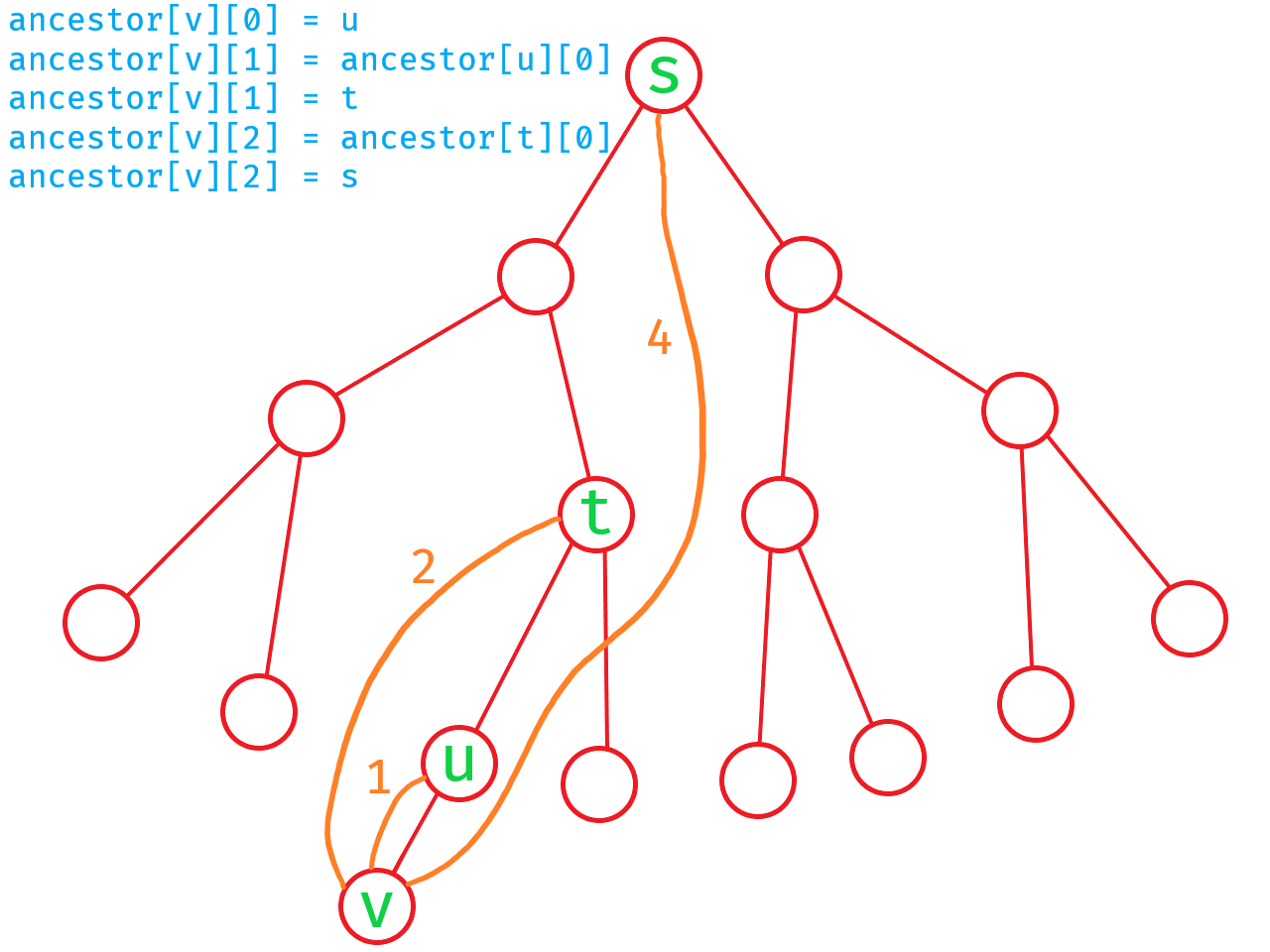
If you just populated this array by searching up the tree \(2^k\) steps each time, you’d have worst case complexity \(O(n^2)\) to build the array. Luckily, we can use the fact that ancestor[v][k] = ancestor[ancestor[v][k-1]][k-1] (In other words, you can move \(2^k\) steps towards the root by first moving \(2^{k-1}\) steps, which we’ve already computed, and then another \(2^{k-1}\) steps from this new position). This reduces the complexity to \(O(n\log_2(n))\)
We do this so that we can find the ancestor \(m\) edges towards the root for any arbitrary \(m\) in \(\log_2(m)\) time, while only using \(\log_2(n)\) space. We’ll see how this gets done later.
1
2
3
4
5
6
7
8
9
10
11
12
13
14
15
16
17
18
19
20
21
22
23
24
25
26
27
28
29
30
31
32
33
34
35
36
37
38
39
40
41
42
43
44
45
46
47
48
49
50
51
class LCA:
"""
vertices are represented as numbers 0->n-1.
"""
# number such that 2^{MAX_LOG} > n. 20 works for n <= 10^6.n
MAX_LOG = 20n
def __init__(self, n_vertices):
self.n = n_vertices
self.adjacent = [[] for _ in range(self.n)]
def add_edge(self, u, v, weight=1):
self.adjacent[u].append((v, weight))
self.adjacent[v].append((u, weight))
def dfs(self, source, c_parent, c_level, c_length):
# Search from the source down the tree and set parent, level, length accordingly.
self.parent[source] = c_parent
self.level[source] = c_level
self.length[source] = c_length
for child, weight in self.adjacent[source]:
if child != c_parent:
self.dfs(child, source, c_level + 1, c_length + weight)
def build(self, root):
# Once edges are added, build the tree/data structure.
self.parent = [None]*self.n
self.level = [None]*self.n
self.length = [None]*self.n
self.dfs(root, -1, 0, 0)
# Compute ancestorn
self.ancestor = [[-1]*self.MAX_LOG for _ in range(self.n)]n
# Initial step: ancestor[v][0] = parent[v]n
for v in range(self.n):n
self.ancestor[v][0] = self.parent[v]n
# Now, compute ancestor[v][k] from 1->MAX_LOGn
for k in range(1, self.MAX_LOG):n
for v in range(self.n):n
if self.ancestor[v][k-1] != -1:n
# Move 2^{k-1} up, then 2^{k-1} again.n
self.ancestor[v][k] = self.ancestor[self.ancestor[v][k-1]][k-1]n
def query(self, u, v, root=None):
# What is the lowest common ancestor of u, v?
# Extension: Make this query from any root vertex you want.
pass # TODO
def dist(self, u, v):
# Find the distance between two vertices - very simple if we have LCA.
pass # TODO
1
2
3
4
5
6
7
8
9
10
11
12
13
14
15
16
17
18
19
20
21
22
23
24
25
26
27
28
29
30
31
32
33
34
35
36
37
38
39
40
41
42
43
44
45
46
47
48
49
50
51
52
53
54
template<typename T = int> struct LCA {
// vertices are represented as numbers 0->n-1.
// number such that 2^{MAX_LOG} > n. 20 works for n <= 10^6.n
int MAX_LOG = 20;n
int n; vector<vector<pair<int, T> > > adjacent;
vi parent, level;
vvi ancestor;n
vector<T> length;
LCA(int n_vertices) : n(n_vertices), adjacent(n), parent(n), level(n), length(n) { }
void add_edge(int u, int v, T weight=1) {
adjacent[u].emplace_back(v, weight);
adjacent[v].emplace_back(u, weight);
}
void dfs(int source, int c_parent, int c_level, T c_length) {
// Search from the source down the tree and set parent, level, length accordingly.
parent[source] = c_parent;
level[source] = c_level;
length[source] = c_length;
for (auto v: adjacent[source])
if (v.first != c_parent)
dfs(v.first, source, c_level+1, c_length+v.second);
}
void build(int root=0) {
// Once edges are added, build the tree/data structure.
dfs(root, -1, 0, 0);
// Compute ancestorn
ancestor.assign(n, vi(MAX_LOG, -1));n
// Initial step: ancestor[v][0] = parent[v]n
for (int v=0; v<n; v++)n
ancestor[v][0] = parent[v];n
// Now, compute ancestor[v][k] from 1->MAX_LOGn
for (int k=1; k < MAX_LOG; k++)n
for (int v=0; v<n; v++)n
if (ancestor[v][k-1] != -1) {n
// Move 2^{k-1} up, then 2^{k-1} again.n
ancestor[v][k] = ancestor[ancestor[v][k-1]][k-1];n
}n
}
int query(int u, int v, int root=-1) {
// What is the lowest common ancestor of u, v?
// Extension: Make this query from any root vertex you want.
// TODO
}
T dist(int u, int v) {
// Find the distance between two vertices - very simple if we have LCA.
// TODO
}
}
Query
That’s actually most of the ingenuity out of the way, now we can get to implementing query.
Provided we want the LCA with respect to the root we called build from, we can define the LCA l of u and v in the following way:
l is the ancestor of u and v maximising level[l].
We also know that level[l] <= min(level[u], level[v]). Using this, we can calculate query(u, v) by:
- Finding the ancestors of
uandv(call thema1,a2) such thatlevel[a1] = level[a2] = min(level[u], level[v]). - Keep moving
a1anda2towards the root (higher and higher ancestors) untila1 == a2. Thena1anda2are the LCA ofuandv.
We can do both of these things on \(\log_2(n)\) time with this ancestor array we’ve generated. Let’s see how:
1
2
3
4
5
6
7
8
9
10
11
12
13
14
15
16
17
18
19
20
21
22
23
24
25
26
27
28
29
30
31
32
33
34
35
36
37
38
39
40
41
42
43
44
45
46
47
48
49
50
51
52
53
54
55
56
57
58
59
60
61
62
63
64
65
66
67
68
69
70
class LCA:
"""
vertices are represented as numbers 0->n-1.
"""
# number such that 2^{MAX_LOG} > n. 20 works for n <= 10^6.
MAX_LOG = 20
def __init__(self, n_vertices):
self.n = n_vertices
self.adjacent = [[] for _ in range(self.n)]
def add_edge(self, u, v, weight=1):
self.adjacent[u].append((v, weight))
self.adjacent[v].append((u, weight))
def dfs(self, source, c_parent, c_level, c_length):
# Search from the source down the tree and set parent, level, length accordingly.
self.parent[source] = c_parent
self.level[source] = c_level
self.length[source] = c_length
for child, weight in self.adjacent[source]:
if child != c_parent:
self.dfs(child, source, c_level + 1, c_length + weight)
def build(self, root):
# Once edges are added, build the tree/data structure.
self.parent = [None]*self.n
self.level = [None]*self.n
self.length = [None]*self.n
self.dfs(root, -1, 0, 0)
self.ancestor = [[-1]*self.MAX_LOG for _ in range(self.n)]
# Initial step: ancestor[v][0] = parent[v]
for v in range(self.n):
self.ancestor[v][0] = self.parent[v]
# Now, compute ancestor[v][k] from 1->MAX_LOG
for k in range(1, self.MAX_LOG):
for v in range(self.n):
if self.ancestor[v][k-1] != -1:
# Move 2^{k-1} up, then 2^{k-1} again.
self.ancestor[v][k] = self.ancestor[self.ancestor[v][k-1]][k-1]
def query(self, u, v, root=None):
# What is the lowest common ancestor of u, v?
# Extension: Make this query from any root vertex you want.
if root is not None:n
pass # TODOn
# assume that u is higher up than v, to simplify the code belown
if self.level[u] > self.level[v]:n
u, v = v, un
# STEP 1: set u and v to be ancestors with the same leveln
for k in range(self.MAX_LOG-1, -1, -1):n
if (self.level[v] - (1 << k) >= self.level[u]):n
# If v is 2^k levels below u, move it up 2^k levels.n
v = self.ancestor[v][k]n
# We can be certain that level[u] = level[v]. Reason: binary representation of all natural numbers.n
# Do we need to move to step 2?n
if (u == v): return un
# STEP 2: find the highest ancestor where u != v. Then the parent is the LCAn
for k in range(self.MAX_LOG-1, -1, -1):n
if (self.ancestor[u][k] != self.ancestor[v][k]):n
# Move up 2^k stepsn
u = self.ancestor[u][k]n
v = self.ancestor[v][k]n
return self.parent[u]n
def dist(self, u, v):
# Find the distance between two vertices - very simple if we have LCA.
pass # TODO
1
2
3
4
5
6
7
8
9
10
11
12
13
14
15
16
17
18
19
20
21
22
23
24
25
26
27
28
29
30
31
32
33
34
35
36
37
38
39
40
41
42
43
44
45
46
47
48
49
50
51
52
53
54
55
56
57
58
59
60
61
62
63
64
65
66
67
68
69
70
71
72
73
74
75
template<typename T = int> struct LCA {
// vertices are represented as numbers 0->n-1.
// number such that 2^{MAX_LOG} > n. 20 works for n <= 10^6.
int MAX_LOG = 20;
int n; vector<vector<pair<int, T> > > adjacent;
vi parent, level;
vvi ancestor;
vector<T> length;
LCA(int n_vertices) : n(n_vertices), adjacent(n), parent(n), level(n), length(n) { }
void add_edge(int u, int v, T weight=1) {
adjacent[u].emplace_back(v, weight);
adjacent[v].emplace_back(u, weight);
}
void dfs(int source, int c_parent, int c_level, T c_length) {
// Search from the source down the tree and set parent, level, length accordingly.
parent[source] = c_parent;
level[source] = c_level;
length[source] = c_length;
for (auto v: adjacent[source])
if (v.first != c_parent)
dfs(v.first, source, c_level+1, c_length+v.second);
}
void build(int root=0) {
// Once edges are added, build the tree/data structure.
dfs(root, -1, 0, 0);
// Compute ancestor
ancestor.assign(n, vi(MAX_LOG, -1));
// Initial step: ancestor[v][0] = parent[v]
for (int v=0; v<n; v++)
ancestor[v][0] = parent[v];
// Now, compute ancestor[v][k] from 1->MAX_LOG
for (int k=1; k < MAX_LOG; k++)
for (int v=0; v<n; v++)
if (ancestor[v][k-1] != -1) {
// Move 2^{k-1} up, then 2^{k-1} again.
ancestor[v][k] = ancestor[ancestor[v][k-1]][k-1];
}
}
int query(int u, int v, int root=-1) {
// What is the lowest common ancestor of u, v?
// Extension: Make this query from any root vertex you want.
if (root != -1) {n
// TODOn
}n
// assume that u is higher up than v, to simplify the code belown
if (level[u] > level[v]) swap(u, v);n
// STEP 1: set u and v to be ancestors with the same leveln
for (int k=MAX_LOG-1, k>=0; k--)n
if (level[v] - (1 << k) >= level[u]) {n
// If v is 2^k levels below u, move it up 2^k levels.n
v = ancestor[v][k];n
}n
// We can be certain that level[u] = level[v]. Reason: binary representation of all natural numbers.n
// Do we need to move to step 2?n
if (u == v) return un
// STEP 2: find the highest ancestor where u != v. Then the parent is the LCAn
for (int k=MAX_LOG; k>=0; k--)n
if (ancestor[u][k] != ancestor[v][k]) {n
// Move up 2^k stepsn
u = ancestor[u][k];n
v = ancestor[v][k];n
}n
return parent[u];n
}
T dist(int u, int v) {
// Find the distance between two vertices - very simple if we have LCA.
// TODO
}
}
Nice! That’s the main functionality of LCA completed.
Corrolaries
Let’s quickly tackle the two remaining implementations:
- Calculating the distance between two vertices
uandvis the same as calculating the distance betweenuandquery(u, v), and adding that to the distance betweenvandquery(u, v) - Calculating the LCA from a particular root, just requires a slight change in perspective. For two vertices
uandv, and custom rootr, the LCA will always be one ofquery(u, v),query(u, r)orquery(v, r).
1
2
3
4
5
6
7
8
9
10
11
12
13
14
15
16
17
18
19
20
21
22
23
24
25
26
27
28
29
30
31
32
33
34
35
36
37
38
39
40
41
42
43
44
45
46
47
48
49
50
51
52
53
54
55
56
57
58
59
60
61
62
63
64
65
66
67
68
69
70
71
72
73
74
75
76
77
78
79
class LCA:
"""
vertices are represented as numbers 0->n-1.
"""
# number such that 2^{MAX_LOG} > n. 20 works for n <= 10^6.
MAX_LOG = 20
def __init__(self, n_vertices):
self.n = n_vertices
self.adjacent = [[] for _ in range(self.n)]
def add_edge(self, u, v, weight=1):
self.adjacent[u].append((v, weight))
self.adjacent[v].append((u, weight))
def dfs(self, source, c_parent, c_level, c_length):
# Search from the source down the tree and set parent, level, length accordingly.
self.parent[source] = c_parent
self.level[source] = c_level
self.length[source] = c_length
for child, weight in self.adjacent[source]:
if child != c_parent:
self.dfs(child, source, c_level + 1, c_length + weight)
def build(self, root):
# Once edges are added, build the tree/data structure.
self.parent = [None]*self.n
self.level = [None]*self.n
self.length = [None]*self.n
self.dfs(root, -1, 0, 0)
self.ancestor = [[-1]*self.MAX_LOG for _ in range(self.n)]
# Initial step: ancestor[v][0] = parent[v]
for v in range(self.n):
self.ancestor[v][0] = self.parent[v]
# Now, compute ancestor[v][k] from 1->MAX_LOG
for k in range(1, self.MAX_LOG):
for v in range(self.n):
if self.ancestor[v][k-1] != -1:
# Move 2^{k-1} up, then 2^{k-1} again.
self.ancestor[v][k] = self.ancestor[self.ancestor[v][k-1]][k-1]
def query(self, u, v, root=None):
# What is the lowest common ancestor of u, v?
# Extension: Make this query from any root vertex you want.
if root is not None:
# Custom root -- see diagrams below for reasoning.n
a = self.query(u, v)n
b = self.query(u, root)n
c = self.query(v, root)n
# Case 1: root is in the same component as u when `a` is removed from the tree. So `b` is the LCAn
if (a == c and c != b) return bn
# Case 2: root is in the same component as v when `a` is removed from the tree. So `a` is the LCAn
if (a == b and c != b) return cn
# Case 3: b and c are above a in the tree. So return an
return an
# assume that u is higher up than v, to simplify the code below
if self.level[u] > self.level[v]:
u, v = v, u
# STEP 1: set u and v to be ancestors with the same level
for k in range(self.MAX_LOG-1, -1, -1):
if (self.level[v] - (1 << k) >= self.level[u]):
# If v is 2^k levels below u, move it up 2^k levels.
v = self.ancestor[v][k]
# We can be certain that level[u] = level[v]. Reason: binary representation of all natural numbers.
# Do we need to move to step 2?
if (u == v): return u
# STEP 2: find the highest ancestor where u != v. Then the parent is the LCA
for k in range(self.MAX_LOG-1, -1, -1):
if (self.ancestor[u][k] != self.ancestor[v][k]):
# Move up 2^k steps
u = self.ancestor[u][k]
v = self.ancestor[v][k]
return self.parent[u]
def dist(self, u, v):
# Find the distance between two vertices
return self.length[u] + self.length[v] - 2 * self.length[self.query(u, v)]n
1
2
3
4
5
6
7
8
9
10
11
12
13
14
15
16
17
18
19
20
21
22
23
24
25
26
27
28
29
30
31
32
33
34
35
36
37
38
39
40
41
42
43
44
45
46
47
48
49
50
51
52
53
54
55
56
57
58
59
60
61
62
63
64
65
66
67
68
69
70
71
72
73
74
75
76
77
78
79
80
81
82
83
84
template<typename T = int> struct LCA {
// vertices are represented as numbers 0->n-1.
// number such that 2^{MAX_LOG} > n. 20 works for n <= 10^6.
int MAX_LOG = 20;
int n; vector<vector<pair<int, T> > > adjacent;
vi parent, level;
vvi ancestor;
vector<T> length;
LCA(int n_vertices) : n(n_vertices), adjacent(n), parent(n), level(n), length(n) { }
void add_edge(int u, int v, T weight=1) {
adjacent[u].emplace_back(v, weight);
adjacent[v].emplace_back(u, weight);
}
void dfs(int source, int c_parent, int c_level, T c_length) {
// Search from the source down the tree and set parent, level, length accordingly.
parent[source] = c_parent;
level[source] = c_level;
length[source] = c_length;
for (auto v: adjacent[source])
if (v.first != c_parent)
dfs(v.first, source, c_level+1, c_length+v.second);
}
void build(int root=0) {
// Once edges are added, build the tree/data structure.
dfs(root, -1, 0, 0);
// Compute ancestor
ancestor.assign(n, vi(MAX_LOG, -1));
// Initial step: ancestor[v][0] = parent[v]
for (int v=0; v<n; v++)
ancestor[v][0] = parent[v];
// Now, compute ancestor[v][k] from 1->MAX_LOG
for (int k=1; k < MAX_LOG; k++)
for (int v=0; v<n; v++)
if (ancestor[v][k-1] != -1) {
// Move 2^{k-1} up, then 2^{k-1} again.
ancestor[v][k] = ancestor[ancestor[v][k-1]][k-1];
}
}
int query(int u, int v, int root=-1) {
// What is the lowest common ancestor of u, v?
// Extension: Make this query from any root vertex you want.
if (root != -1) {
// Custom root -- see diagrams below for reasoning.n
int a = query(u, v);n
int b = query(u, root);n
int c = query(v, root);n
// Case 1: root is in the same component as u when `a` is removed from the tree. So `b` is the LCAn
if (a == c and c != b) return b;n
// Case 2: root is in the same component as v when `a` is removed from the tree. So `a` is the LCAn
if (a == b and c != b) return c;n
// Case 3: b and c are above a in the tree. So return an
return a;n
}
// assume that u is higher up than v, to simplify the code below
if (level[u] > level[v]) swap(u, v);
// STEP 1: set u and v to be ancestors with the same level
for (int k=MAX_LOG-1, k>=0; k--)
if (level[v] - (1 << k) >= level[u]) {
// If v is 2^k levels below u, move it up 2^k levels.
v = ancestor[v][k];
}
// We can be certain that level[u] = level[v]. Reason: binary representation of all natural numbers.
// Do we need to move to step 2?
if (u == v) return u
// STEP 2: find the highest ancestor where u != v. Then the parent is the LCA
for (int k=MAX_LOG; k>=0; k--)
if (ancestor[u][k] != ancestor[v][k]) {
// Move up 2^k steps
u = ancestor[u][k];
v = ancestor[v][k];
}
return parent[u];
}
T dist(int u, int v) {
// Find the distance between two vertices
return length[u] + length[v] - 2 * length[query(u, v)];n
}
}
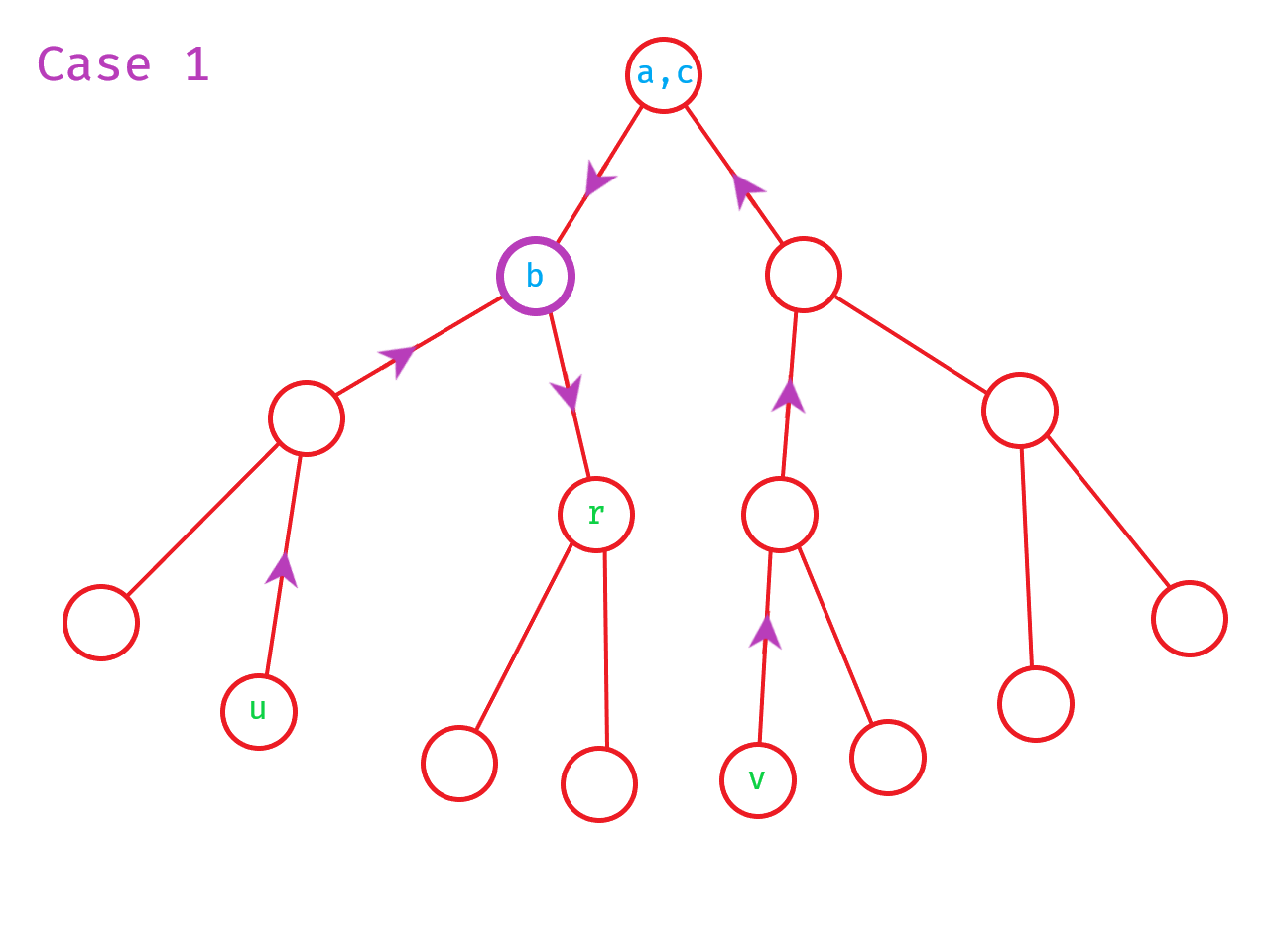
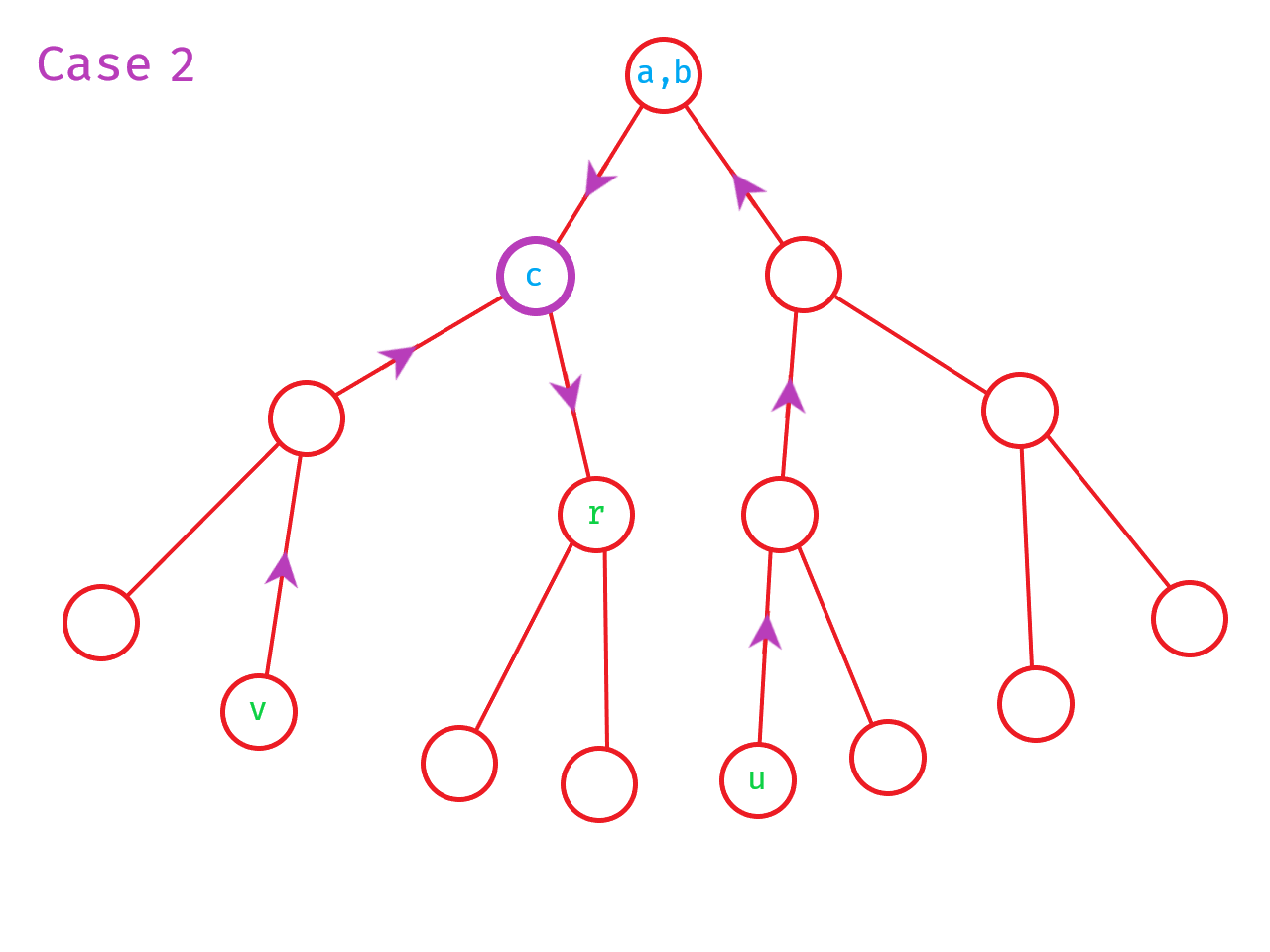
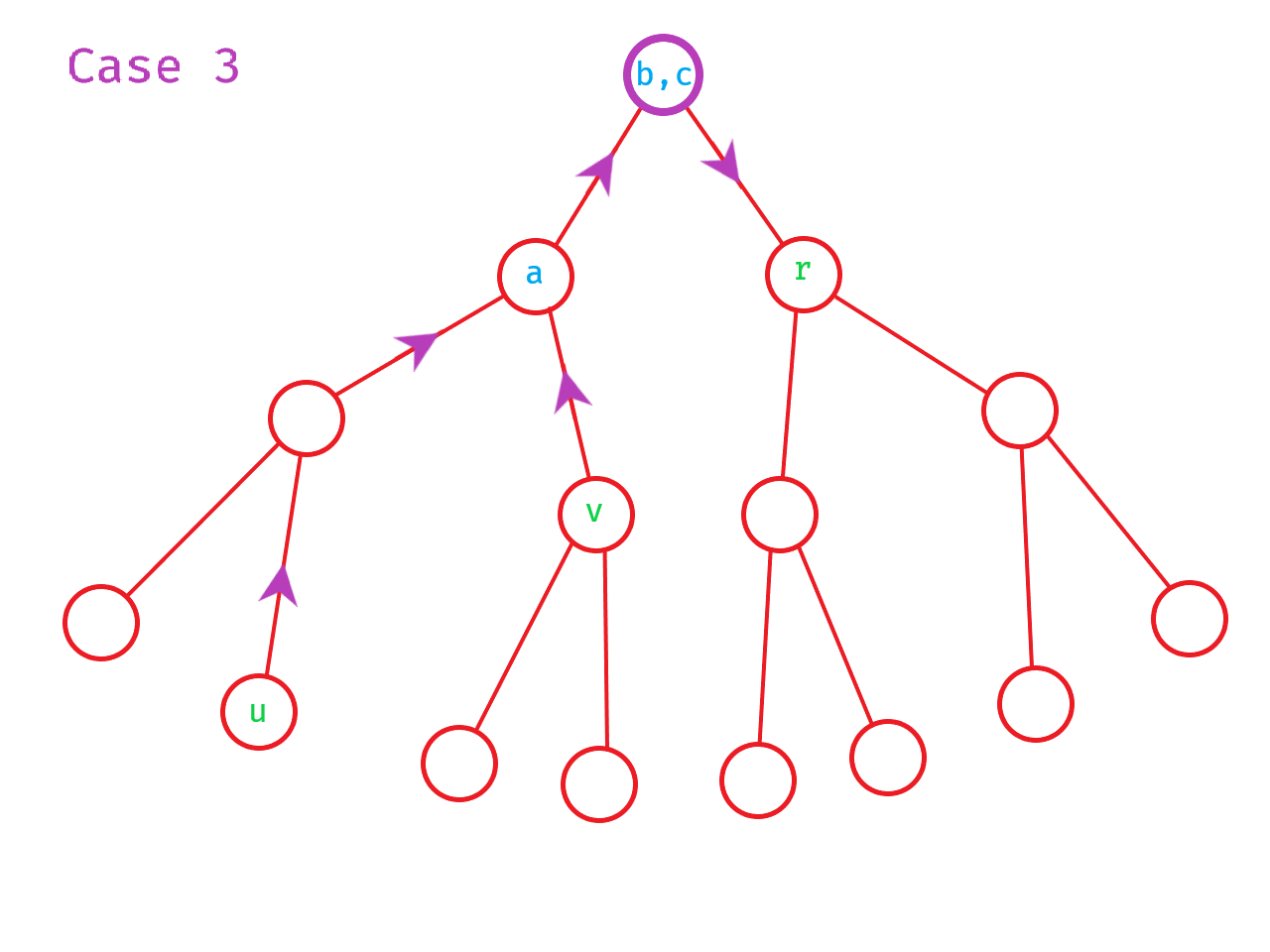
And that’s our implementation done! Now get out there and solve some problems!
